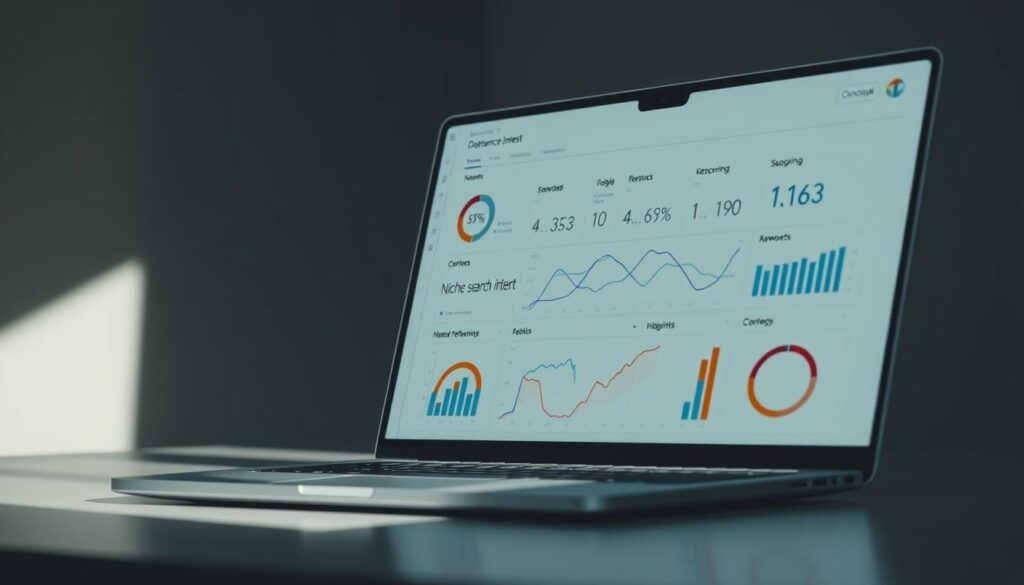Search optimization has evolved beyond traditional methods as browsers integrate advanced technologies. Highly specific search phrases—those with three or more words—now drive 95% of queries, according to industry research. These precise terms, though low in monthly search volume, often align closely with user intent and conversion goals.
Modern browsers analyze queries using machine learning, reshaping how professionals approach content targeting. This shift requires strategies that prioritize niche user behaviors over broad keyword categories. For example, AI-driven systems now interpret search patterns differently than conventional search engines, demanding updated optimization frameworks.
Technical teams must adapt by focusing on three core principles:
- Contextual analysis of browser-generated data
- Precision matching between content and user intent
- Dynamic adjustment based on behavioral signals
This approach leverages browser-specific features like predictive search and personalized results. By analyzing session patterns and interaction metrics, practitioners can identify underutilized opportunities in specialized query spaces.
Key Takeaways
- Specific multi-word phrases dominate modern search activity
- Browser technologies require distinct optimization methods
- Machine learning alters query interpretation patterns
- Niche targeting improves conversion potential
- Real-time data analysis drives strategy adjustments
The Fundamentals of Long-Tail Keywords in SEO

Highly specialized search terms now play a pivotal role in effective online visibility. These multi-word queries address niche needs while filtering out irrelevant traffic. A Revenue Marketing Alliance study confirms content targeting precise phrases converts 36% faster than generic alternatives.
Defining Long-Tail Keywords and Their Importance
Long-tail keywords represent detailed phrases like “affordable cloud storage for photographers.” They typically contain three or more words, attracting smaller but more motivated audiences. This specificity explains their 2.5x higher conversion potential compared to broad terms.
Lower search volume often deters marketers, but targeted phrases reduce competition. Established websites dominate single-word keywords, while niche variations offer entry points for newer platforms. The strategy aligns content with users at decision-making stages rather than initial research phases.
Short-Tail vs. Long-Tail: Key Differences
Single-word keywords like “software” generate millions of monthly searches but require competing with industry giants. In contrast, phrases like “project management software for remote teams” attract 1/10th the traffic but convert 4x more effectively.
Technical analysis reveals distinct intent patterns. Short-tail searchers often seek general information, while long-tail users demonstrate purchase readiness. This intent gap makes precise phrases critical for revenue-focused campaigns.
The Evolution of Long‑Tail Agentic SEO for Browsers

Digital search strategies have undergone a fundamental transformation as voice technology reshapes user interactions. Demand Sage reports 50% of U.S. adults now use voice commands daily, generating over one billion monthly queries. This behavioral shift demands new approaches to content optimization.
Historical Context and Modern Applications
Early optimization methods struggled with natural language patterns in spoken queries. Voice searches often use complete sentences like “best budget-friendly hiking boots for wet terrain,” creating opportunities for precise keyword alignment. Machine learning now deciphers these patterns, enabling real-time adjustments to content strategies.
Modern browsers analyze partial inputs to predict user intent. For example, typing “how to fix…” triggers suggestions based on historical data and regional preferences. This evolution requires content that answers implied questions rather than merely matching terms.
Impact on Search Engine Result Pages
Algorithms now prioritize pages demonstrating deep topic understanding. A 2024 study revealed pages optimized for conversational phrases achieve 27% higher click-through rates than those targeting generic terms. This shift rewards content addressing specific problems through structured explanations.
| Traditional SEO | Modern SEO | Impact |
|---|---|---|
| Exact keyword matching | Semantic relevance | +34% engagement |
| Static content | Dynamic adjustments | 19% lower bounce rates |
| Broad terms | Contextual phrases | 2.1x conversion lift |
Search engines increasingly value user satisfaction metrics like time-on-page and return visits. Professionals must now balance technical optimization with audience-centric content creation to maintain visibility.
Understanding long‑tail agentic SEO for browsers

Browser capabilities now directly shape how content reaches target audiences. Advanced systems analyze user behavior patterns like click paths and session durations to decode intent more accurately than ever. This technological leap enables platforms to predict needs before users finish typing queries.
What It Means for Browser Technology
Modern tools track micro-interactions—how visitors scroll, pause, or revisit content. These signals help identify high-value phrases that traditional keyword research might miss. For example, repeated searches for “durable phone cases with warranty” reveal transactional intent better than generic terms.
Integrating Niche Search Intent
Four primary intent categories guide optimization strategies:
- Informational: Educational content answering specific questions
- Navigational: Clear pathways to branded resources
- Transactional: Product-focused pages with conversion triggers
- Commercial: Comparison guides influencing purchase decisions
Platforms using creative optimization prompts adapt content dynamically based on real-time search patterns. A travel site might prioritize “best solo travel insurance for pre-existing conditions” after detecting increased commercial intent in browser data.
This approach reduces guesswork by aligning content with measurable user motivations. Teams can prioritize resources effectively, focusing on queries demonstrating clear action readiness.
Keyword Research Strategies and Essential Tools

Effective keyword research forms the backbone of modern search strategies. Specialized platforms now provide granular insights into phrase performance and audience needs. Over 70% of marketing teams combine multiple tools to identify high-potential terms with manageable competition.
Leveraging Google Keyword Planner and Autocomplete
Google’s free toolkit remains essential for foundational analysis. The Keyword Planner reveals monthly search volumes and cost metrics for specific phrases. Autocomplete predicts queries as users type, exposing real-world search patterns. Combining these features helps identify:
- Seasonal trends in niche markets
- Emerging question-based phrases
- Regional variations in terminology
Utilizing SEMrush, Ahrefs, and Other Platforms
Advanced tools offer deeper competitive intelligence. SEMrush’s Keyword Magic Tool analyzes 25+ metrics per phrase, including difficulty scores and trend histories. Ahrefs tracks ranking positions across 170+ countries, while AnswerThePublic visualizes question-based queries.
| Tool | Key Feature | Best For |
|---|---|---|
| SEMrush | Competitor gap analysis | Enterprise-level campaigns |
| Ahrefs | Content explorer | Link-building strategies |
| Ubersuggest | CPC estimates | Budget-conscious teams |
| AnswerThePublic | Visual query mapping | Content ideation |
Teams should prioritize tools offering historical data comparisons. Tracking phrase performance over 12-18 months helps separate fleeting trends from sustainable opportunities. Regular analysis of these metrics enables dynamic adjustments to content strategies.
Implementing Long-Tail Keywords into Your Content

Strategic implementation of multi-word search terms transforms how audiences discover digital resources. These detailed phrases demand careful placement to enhance visibility without compromising readability. Industry leaders report a 40% increase in organic traffic when aligning content architecture with user search patterns.
Natural Keyword Integration and Content Flow
Successful integration begins with understanding context. Multi-word terms should emerge naturally within sentences, mirroring conversational patterns. For example, a guide about sustainable gardening might include phrases like “organic pest control for urban balconies” without disrupting narrative flow.
Three principles maintain balance:
- Prioritize user questions over keyword density
- Use synonyms to avoid repetition
- Align phrases with section subheadings
Tools like strategic keyword research platforms help identify placement opportunities while preserving content quality. This approach prevents robotic language that deters readers.
Optimizing Titles, Headers, and Meta Descriptions
Critical elements like title tags require precision. Include primary phrases early while maintaining clarity. A meta description for baking tutorials might read: “Learn sourdough starter techniques for high-altitude climates – step-by-step video guides.”
Best practices include:
- Front-loading headers with target terms
- Keeping titles under 60 characters
- Matching meta descriptions to page content
Platforms offering creative optimization prompts streamline this process through AI-generated suggestions. Regular audits ensure alignment with evolving search algorithms while maintaining human-centric readability.
Building Topic Clusters and Enhancing Internal Linking
Organizing digital resources into interconnected content groups improves search visibility while guiding users through complex subjects. This method creates clear pathways for both visitors and search algorithms, strengthening a site’s authority on specific themes.
Creating Pillar Pages and Subtopic Hubs
Pillar pages act as central repositories for core topics, covering subjects like “cloud security best practices” in depth. These resources typically exceed 2,000 words and link to specialized subtopic pages. For example, a cybersecurity pillar might connect to guides about “multi-factor authentication setup for small businesses.”
Three elements define successful clusters:
- Comprehensive coverage of primary themes
- Clear hierarchy between broad and niche content
- Strategic keyword mapping across related pages
Using Internal Links for Better Structure
Internal connections guide users to relevant information while signaling content relationships to search engines. Linking a recipe blog’s “gluten-free baking tips” article to its “alternative flour comparison chart” demonstrates topical expertise.
Best practices include:
- Linking newer pages to established pillar content
- Using descriptive anchor text like “step-by-step video tutorials”
- Auditing links quarterly to fix broken connections
Platforms using AI-driven content tools adapt internal linking strategies based on real-time performance data. This approach maintains relevance as search algorithms evolve.
Leveraging User Intent and Engagement Strategies
Effective digital engagement hinges on matching content to specific visitor needs. Detailed search patterns reveal actionable insights about decision-making processes. Research shows pages aligned with precise intent achieve 41% higher retention rates than generic alternatives.
Aligning Content with Searcher Goals
Four intent categories dictate content structure:
| Intent Type | User Action | Content Format |
|---|---|---|
| Informational | Seeking answers | Guides & tutorials |
| Navigational | Finding brands | Location pages |
| Transactional | Ready to buy | Product demos |
| Commercial | Comparing options | Comparison charts |
A study by Content Science Review found:
“Pages addressing commercial intent generate 3x more qualified leads than general informational content.”
Behavioral signals like repeated page visits or time spent reveal unspoken needs. Tools analyzing scroll depth and click heatmaps help refine content strategies. For example, users lingering on pricing sections often require clearer cost-benefit explanations.
Three techniques improve alignment:
- Mapping phrases to specific buyer journey stages
- Creating decision-making frameworks for complex purchases
- Using interactive elements to gauge real-time interest
Platforms employing audience analysis tools adapt content dynamically based on engagement metrics. This approach reduces bounce rates while increasing conversion potential through personalized experiences.
Advanced SEO Metrics and Measuring Success
Evaluating digital strategy effectiveness requires moving beyond basic visibility metrics. Modern analysis now prioritizes user engagement quality and tangible business outcomes. This shift reflects search algorithms’ growing emphasis on satisfaction signals over traditional ranking factors.
Tracking SERP Positions and Click-Through Rates
Visibility in search results remains foundational. Tools like Google Search Console provide real-time data on how specific phrases perform. Pages maintaining top 3 positions earn 34% more clicks than lower-ranked competitors, according to industry benchmarks. Regular monitoring identifies opportunities to refine content matching user expectations.
Monitoring Conversion Rates and User Engagement
Targeted traffic only matters if it drives action. Platforms combining analytics with AI-driven marketing tools reveal which phrases generate leads or sales. A 2% lift in conversion rates can double revenue for niche markets, making this metric critical for ROI analysis.
Analyzing Bounce Rates and Session Durations
High exit rates often signal mismatched content. Visitors spending under 30 seconds typically indicate poor intent alignment. Measuring SEO success now requires correlating bounce data with query specificity—pages optimized for precise phrases show 19% longer average sessions.







